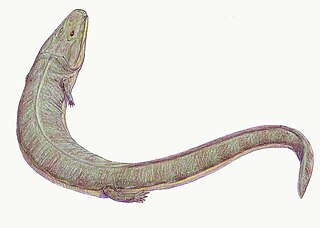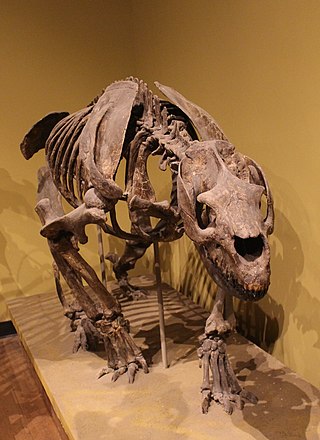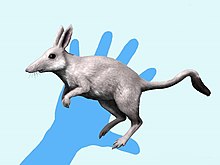
Placodus was a genus of marine reptiles belonging to the order Placodontia, which swam in the shallow seas of the middle Triassic period. Fossils of Placodus have been found in Central Europe and China.

Zalambdalestes was a eutherian mammal, most likely not a placental due to the presence of an epipubic bone, living during the Upper Cretaceous in Mongolia.

Macrauchenia was a large, long-necked and long-limbed, three-toed native South American ungulate in the order Litopterna. The genus gives its name to its family, the Macraucheniidae or "robust litopterns". Like other litopterns, it is most closely related to the odd-toed ungulates (Perissodactyla), from which litopterns diverged approximately 66 million years ago. The oldest fossils in the genus date to the late Miocene, around seven million years ago, and M. patachonica disappears from the fossil record during the late Pleistocene, around 20,000-10,000 years ago. M. patachonica is one of the last and best known member of the family and is known primarily from the Luján Formation in Argentina, but is known from localities across southern South America. Another genus of macraucheniid Xenorhinotherium was present in northeast Brazil and Venezuela during the Late Pleistocene. The type specimen was discovered by Charles Darwin during the voyage of the Beagle. In life, Macrauchenia may have resembled a humpless camel, though the two taxa are not closely related. It fed on plants in a variety of environments across what is now South America. Among the species described, M. patachonica and M. ullomensis are considered valid; M. boliviensis is considered a nomen dubium; and M. antiqua has been moved to the genus Promacrauchenia.

Greererpeton burkemorani is an extinct genus of colosteid stem-tetrapods from the Early Carboniferous period of North America. Greererpeton was first described by famed vertebrate paleontologist Alfred S. Romer in 1969, based on a skull and partial skeleton from the Bluefield Formation. The skull was redescribed by Timothy R. Smithson in 1982, while postcranial remains were redescribed by Stephen J. Godfrey in 1989.

Cladosictis is an extinct genus of South American metatherian from Patagonia, Argentina and Chile.

Hapalops is an extinct genus of ground sloth from the Early to Late Miocene of Brazil, Bolivia, Colombia, and Argentina in South America.

Eurotamandua is an extinct genus of mammal from extinct family Eurotamanduidae that lived during the middle Eocene.

Chapalmalania is an extinct genus of procyonid from the Late Miocene or Early Pliocene to Early Pleistocene of Argentina, Venezuela, and Colombia.

Didolodus is an extinct genus of mammals from Middle Eocene Argentina. It is an ungulate mammal of uncertain affinities, possibly related to Litopterna, though this is uncertain due to the lack of reliable post-cranial remains, and for now remains Meridiungulata incertae sedis. Its remains were found in the Sarmiento Formation of Patagonia.

Diadiaphorus is an extinct genus of litoptern mammal from the Miocene of Argentina and Bolivia, South America.

Thoatherium is an extinct genus of litoptern mammals from the Early Miocene of Argentina. Fossils of the genus have been found in the Santa Cruz Formation in Argentina.

Theosodon is an extinct genus of litoptern mammal from the Early to Middle Miocene of South America.

Notostylops is a genus of extinct South American ungulates from Eocene Argentina. Fossils of the genus have been found in the Sarmiento, Casamayor, Andesitas Huancache and Koluel Kaike Formations.

Pachyrukhos is an extinct genus of hegetotheriid notoungulate from the Early to Middle Miocene of Argentina and Chile. Fossils of this genus have been found in the Collón Curá, Sarmiento and Santa Cruz Formations of Argentina and the Río Frías Formation of Chile.

Thomashuxleya is an extinct genus of notoungulate mammal, named after famous 19th-century biologist Thomas Huxley.

Rhynchippus is an extinct genus of notoungulate mammals from the Late Oligocene of South America. The genus was first described by Florentino Ameghino in 1897 and the type species is R. equinus, with lectotype MACN A 52–31. Fossils of Rhynchippus have been found in the Agua de la Piedra and Sarmiento Formations of Argentina, the Salla and Petaca Formations of Bolivia, the Tremembé Formation of Brazil, and the Moquegua Formation of Peru.

Scarrittia is an extinct genus of hoofed mammal of the family Leontiniidae, native to South America during the Late Oligocene epoch.

Homalodotherium is an extinct genus of notoungulate mammals native to South America. Fossils of Homalodotherium have been found in the Middle Miocene Santa Cruz Formation of Argentina and the Río Frías Formation of Chile.

Adinotherium is an extinct genus of Toxodontidae, large bodied hoofed ungulates which inhabited South America during the Middle to Late Miocene, from 17.5 to 6.8 Ma and existed for approximately 10.7 million years, Santacrucian to Huayquerian in the South American land mammal ages (SALMA). Fossils of Adinotherium have been found in the Santa Cruz and Ituzaingó Formations of Argentina and the Chucal and Río Frías Formations of Chile.

Ischyromys is an extinct genus of rodent from North America.
























